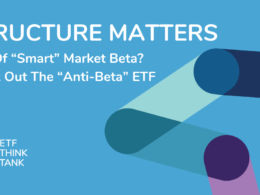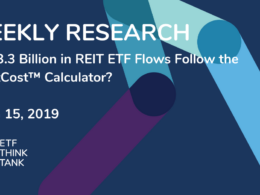Last week, Mike Venuto sat down with Connor O’Brien, CEO of O’Shares, to discuss markets, thematic ETFs and Fixed Income investing. The conversation drifted toward concerns with bonds, going forward from two key points:
- Expected returns compared to risk
- Role in asset allocation as correlation increases

The debate on the future utility of bonds to investors will continue, but here at the ETF Think Tank, we were inspired to dive deep into the available landscape of fixed income ETFs for this week’s research note.
1.1 Trillion Served
In the US, there are 424 ETFs focused on fixed income, with assets of about $1.14 Trillion (about 22% of US ETF AUM). This excludes leveraged/inverse, preferred, and allocation ETFs in our Toroso Security Master. The weighted average expense ratio for bond ETFs is only 14.4 bps, which is less than the overall industry, at about 18bps.

Bad Bond Benchmarks
The table above breaks down the assets, listings, and fees of fixed income ETFs by investment approach. Not surprisingly, the bulk of the assets (84.5%) are in traditional market weighted passive ETFs. Think Tank sponsor Jay McAndrew, of Columbia Threadneedle, has often referred to these type of passive funds as “bad bond benchmarks,” because they are structured in a way that overweight the largest issuers of debt. There are two interesting surprises in the table above:
- The number of listings is about equal; about one-third of bond ETFs are in each investment approach.
- There are almost double the amount of assets in Active Fixed Income when compared to Non-Traditional Passive.
Fixed Income Volatility
Earlier, we asked if bonds are boring. Below, however, we look at the best and worst performing fixed income ETFs in 2021 compared to 2020, and find volatility that is anything but boring. Let’s start with the worst performers:

The above table indicates that most of the worst preforming fixed income ETFs in 2021 are traditional passive, long duration treasury ETFs. The returns in 2020 for these same funds were 17% to 24%. Now let’s look at 2021’s best performers:

The best performers in 2021 are bonds with equity-like characteristics: high yield and convertibles. There are also four active funds that make the list. There are stark differences with approaches, volatility and results when comparing the best and worst performing fixed income ETFs of 2021 and a sign of the times. The fact is that given an almost 40-year bull market for bonds the conditions for a static 60/40 model do not make sense if an investor is looking to bonds for preservation of capital, buying power or cash flow. Our point is that any bond allocation today needs to be reviewed. We expect exciting times in this area for investors and therefore those looking at this allocation need to review how they can be different rather than traditional.
*Past performance is not indicative of future results.
Disclosure
The information provided here is for financial professionals only and should not be considered an individualized recommendation or personalized investment advice. The investment strategies mentioned here may not be suitable for everyone. Each investor needs to review an investment strategy for his or her own particular situation before making any investment decision.
All expressions of opinion are subject to change without notice in reaction to shifting market conditions. Data contained herein from third party providers is obtained from what are considered reliable sources. However, its accuracy, completeness or reliability cannot be guaranteed.
Examples provided are for illustrative purposes only and not intended to be reflective of results you can expect to achieve.
All investments involve risk, including possible loss of principal.
The value of investments and the income from them can go down as well as up and investors may not get back the amounts originally invested, and can be affected by changes in interest rates, in exchange rates, general market conditions, political, social and economic developments and other variable factors. Investment involves risks including but not limited to, possible delays in payments and loss of income or capital. Neither Toroso nor any of its affiliates guarantees any rate of return or the return of capital invested. This commentary material is available for informational purposes only and nothing herein constitutes an offer to sell or a solicitation of an offer to buy any security and nothing herein should be construed as such. All investment strategies and investments involve risk of loss, including the possible loss of all amounts invested, and nothing herein should be construed as a guarantee of any specific outcome or profit. While we have gathered the information presented herein from sources that we believe to be reliable, we cannot guarantee the accuracy or completeness of the information presented and the information presented should not be relied upon as such. Any opinions expressed herein are our opinions and are current only as of the date of distribution, and are subject to change without notice. We disclaim any obligation to provide revised opinions in the event of changed circumstances.
The information in this material is confidential and proprietary and may not be used other than by the intended user. Neither Toroso or its affiliates or any of their officers or employees of Toroso accepts any liability whatsoever for any loss arising from any use of this material or its contents. This material may not be reproduced, distributed or published without prior written permission from Toroso. Distribution of this material may be restricted in certain jurisdictions. Any persons coming into possession of this material should seek advice for details of and observe such restrictions (if any).












